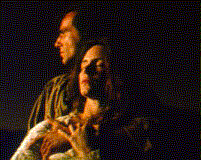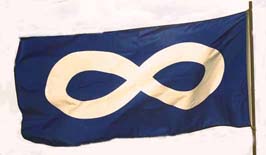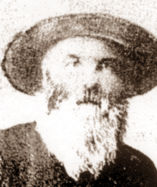FRONTIER HERITAGE - SUMMARY
The course is aimed at helping us discover both the common threads and the
differentiating patterns that characterize frontier experiences of European
and Native Americans in Canada and the United States. The course also attempts
to explore the experiences of both men and women in these groups and of other
minority groups where relevant. If we are to treasure the diversity of our cultures,
we need to understand the archetypes and stereotypes which blur and obscure
the ways in which indigenous and European cultures changed and continue to change
each other. Such patterns have been the focus of scholary work since 1893 when
Frederick Jackson
Turner announced the closing of the American frontier and speculated about
the significance
of the frontier in American history. A similar set of speculations about
Canadian
character is the work of Margaret Atwood.
Last of the Mohicans
 Last of the
Mohicans is one of two films we use to open our discussion of the fontier
experience. James Fenimore Cooper's novel of the same name has inspired a number
of film versions. It is a tale we keep telling ourselves with slightly different
emphases. What makes it interesting for our purposes is precisely its status as
one of the continuing myths of American culture. The most recent version of this
movie
differs significantly from Cooper's novel and earlier films. You might want to
compare Cooper's version of a meeting between
Magua, the Huron ally of the French, and the French commandant, Montcalm, with
the same scene in the film. You can also explore the Mohican perspective on
the history of their people. Prepare for our discussion by printing the Last
of the Mohicans Discussion Guide and bringing it to class.
Last of the
Mohicans is one of two films we use to open our discussion of the fontier
experience. James Fenimore Cooper's novel of the same name has inspired a number
of film versions. It is a tale we keep telling ourselves with slightly different
emphases. What makes it interesting for our purposes is precisely its status as
one of the continuing myths of American culture. The most recent version of this
movie
differs significantly from Cooper's novel and earlier films. You might want to
compare Cooper's version of a meeting between
Magua, the Huron ally of the French, and the French commandant, Montcalm, with
the same scene in the film. You can also explore the Mohican perspective on
the history of their people. Prepare for our discussion by printing the Last
of the Mohicans Discussion Guide and bringing it to class.
Black Robe
This film
provides a sharp contrast to Last of the Mohicans in every way. It
is based on research and a novel of the same title written by Brian Moore
who also wrote the screen play. It explores the relationships between the
First Nations and the Jesuit missionaries who sought to "convert" them to
christianity. Roger Ebert's review
of the film explores the background and explains the reception the film
received from critics and audiences including Ebert. If Last of the
Mohichans is a story we keep telling ourselves, Black Robe may
be a story we don't want to hear. What interests us is why. Prepare for
our discussion by printing the Black Robe
Discussion Guide and bringing it to class.
Spirit of the Border
Zane Grey says in his introduction
that he wrote Spirit of the Border, to set the record straight on a great
indian fighter, Lew Wetzel,
and to honor his ancestors. The problem with the
stories we tell ourselves is that we believe them, especially if the fiction we're
reading is "historical." Allan W.Eckert's account of the events clarifies who
was responsible for the deaths of the Christianized Indians. Apparently Ebenezer
Zane's Journal, or his descendant's retelling of its contents, was the story they
wanted to tell themselves or us, rather than the story of a
savage attack by revolutionary colonists on Native Americans who had accepted
their religion, and who in the name of non-violence refused to ally themselves
with either the yankees or the soldiers of the crown. Prepare for our discussion
by printing the Spirit of the Border Discussion Guide
and bringing it to class.
The Métis
 In the Canadian
films Ikwe and Mistress Madelaine
we meet, a people who came to view themselves as a new people,the Métis of Canada and the United
States, a people born of the meeting between peoples of the First Nations
and Europeans, living in the Great Lakes region and in the Canadian Northwest.
We already encountered one of the Métis' forebearers, the young Frenchman
who travels with the Jesuit missionary in Black Robe. The Métis
are descendants of French traders and peasants who married First Nation women.
What distinguises them is that they chose to stay on the frontier rather than
return to civilization. Ikwe chronicles the process that led to the emergence
of the new people. Mistress Madelaine illustrates the difficulties the
Métis faced in the development of a new community at Winnipeg. Lord Selkirk,
a Scotch noble, purchased Rupert's Land (all of Western Canada, including parts
of present day Minnesota, North Dakota and Montana) from the Hudson's Bay company.
Selkirk purchased the land to establish a colony of displaced Scottish peasants
and retired Métis employees of the HBC at the site of present day Winnipeg.
His agent, Governor Semple, siezed their supplies of pemmican, a staple of the
traders, and tried to force the Métis, many of whom worked for the Northwest
Fur Company, to restrict their trading to the colony and the Hudson's Bay Company.
These actions and the treatment of the Métis illustrated in Mistress
Madelaine resulted in the Battle of
Seven Oaks.
In the Canadian
films Ikwe and Mistress Madelaine
we meet, a people who came to view themselves as a new people,the Métis of Canada and the United
States, a people born of the meeting between peoples of the First Nations
and Europeans, living in the Great Lakes region and in the Canadian Northwest.
We already encountered one of the Métis' forebearers, the young Frenchman
who travels with the Jesuit missionary in Black Robe. The Métis
are descendants of French traders and peasants who married First Nation women.
What distinguises them is that they chose to stay on the frontier rather than
return to civilization. Ikwe chronicles the process that led to the emergence
of the new people. Mistress Madelaine illustrates the difficulties the
Métis faced in the development of a new community at Winnipeg. Lord Selkirk,
a Scotch noble, purchased Rupert's Land (all of Western Canada, including parts
of present day Minnesota, North Dakota and Montana) from the Hudson's Bay company.
Selkirk purchased the land to establish a colony of displaced Scottish peasants
and retired Métis employees of the HBC at the site of present day Winnipeg.
His agent, Governor Semple, siezed their supplies of pemmican, a staple of the
traders, and tried to force the Métis, many of whom worked for the Northwest
Fur Company, to restrict their trading to the colony and the Hudson's Bay Company.
These actions and the treatment of the Métis illustrated in Mistress
Madelaine resulted in the Battle of
Seven Oaks.
Tchipayuk
 Lavalle's
novel takes up the story of the Metis about 50 years after Seven Oaks. While some
of Cuthbert Grant's people are trying to maintain the Métis way, a blending
of European and First Nation life styles, others are trying to fit into the emerging
Euro-Canadian society. Askik, the protagonist of the novel, seeks education and
wealth, dreams of marrying his superior's daughter, and tries to decipher who
he is. During the 20 years Askik moves from youth to manhood, his people, under
the leadership of Louis Riel, are
engaged in their final and decisive struggles with the emerging nation of Canada.
Askik remains uninvolved and unconcerned about these events until the dominant
culture in the East rejects him and he returns to the West as a reporter to witness
the last battle between the Métis and the Canadian government. Louis Riel
and his general Gabriel Dumont
lead their people and several tribes of the First Nations at the Battle
of Batoche. Where they make a last defense of the way of life and the land
they have come to love E. Pauline Johnson's
short story ,"As
It Was in the Beginning" helps carry the story of People of mixed descent
into the twentieth century, and provides us with a connection to Louise Erdrich's
Tracks.
Lavalle's
novel takes up the story of the Metis about 50 years after Seven Oaks. While some
of Cuthbert Grant's people are trying to maintain the Métis way, a blending
of European and First Nation life styles, others are trying to fit into the emerging
Euro-Canadian society. Askik, the protagonist of the novel, seeks education and
wealth, dreams of marrying his superior's daughter, and tries to decipher who
he is. During the 20 years Askik moves from youth to manhood, his people, under
the leadership of Louis Riel, are
engaged in their final and decisive struggles with the emerging nation of Canada.
Askik remains uninvolved and unconcerned about these events until the dominant
culture in the East rejects him and he returns to the West as a reporter to witness
the last battle between the Métis and the Canadian government. Louis Riel
and his general Gabriel Dumont
lead their people and several tribes of the First Nations at the Battle
of Batoche. Where they make a last defense of the way of life and the land
they have come to love E. Pauline Johnson's
short story ,"As
It Was in the Beginning" helps carry the story of People of mixed descent
into the twentieth century, and provides us with a connection to Louise Erdrich's
Tracks.
Jeremiah Johnson
 Robert Redford became the '70s incarnation of the Natty Bumpo (Hawkeye)
archetype based on his performance as Jeremiah
Johnson, last of the mountain men; these frontiersmen were American trappers
working out of St Louis in the Rocky Mountains between 1810 and 1840. The mountain man has the same civilization
hating, wilderness loving, character as Hawkeye and Lew Wetzel. The film also
supplies the typical stereotyped portrait of the faithful native wife. If you
want to read about such a hero you might try A.B. Guthrie's Big
Sky Country and read the story of Boone Caudill and Teal Eyes.
Robert Redford became the '70s incarnation of the Natty Bumpo (Hawkeye)
archetype based on his performance as Jeremiah
Johnson, last of the mountain men; these frontiersmen were American trappers
working out of St Louis in the Rocky Mountains between 1810 and 1840. The mountain man has the same civilization
hating, wilderness loving, character as Hawkeye and Lew Wetzel. The film also
supplies the typical stereotyped portrait of the faithful native wife. If you
want to read about such a hero you might try A.B. Guthrie's Big
Sky Country and read the story of Boone Caudill and Teal Eyes.
Fools Crow
James Welch's remarkable novel, Fools
Crow, enables us to see
the montain men and the settlers from the perspective of the people, the
Loneeater band of the Pikuni (Blackfeet).
The event described in the novel occur around 1870 in the
upper Missouri country and represent yet another instance of betrayal
and pointless slaughter. At the same time Fools Crow and his band
demonstrate courage and a capacity to persist in spite of the advancing European
culture.
Shane and Slogum House
Shane
is a story of a frontier community as it begins to change to an outpost of civilization.
The film and the novel it is based on are considered to be "classic
westerns." For us the question is why is this story a classic? Why
isn't the novel we are pairing with it, Slogum House by Marie
Sandoz, a "classic," and/or why hasn't it been made into a movie?
Another interesting question is who are the people on the frontier in both oof
these westerns? ow does the cast of characters differ from thos we've found
in the works we've previously examined? As we examine our own mythologies, the
mythologies we
live by, and we think about who we tell each other stories
about, we begin to get some insight into why our leaders try to associate themselves
with the west and try to act and talk like the heroes of these tales. We will
also discover why we feel like we do about stories like those Sandoz
tells.
Legends of the Fall
This film,
based on a novel by Jim Harrison, explores the impact of the closing of the
frontier on the kind of rugged individualist character lionized in American
stories and histories. What happens to the frontier hero when the frontier disappears?
As usual the role assigned to women in such stories is troublesome and misleading.
For novels that provide more realistic accounts of women on the closing frontier
in Montana visit Amazon Books and search their database using the Advanced
Query search engine. Type in "Montana and Women ranchers." Examining reviews of this film is interesting
because the critics conclusions are so contradictory. Compare Roger Ebert's
with those in the Washinton Post for example.
Tracks
Louise Erdrich's
novel, Tracks, the final reading for this course straddles borders and
frontiers and takes us back to the Turtle Mountain region of Canada and the
United States, home of a mixed band of Ojibwe, Sioux Métis. It explores
the blending of traditions and the rootedness in place characteristic of first
peoples and the Métis. Some of the controversy
about whether someone who is part Native American and who has never lived on
the reservations can speak for people of the First Nations misses what our literature
and our history are about. The questions of who we are and whether we belong,
if we are mixed, Métis or "pure", Scotch, Irish, Norwegian, German, French,
Italian, Huron, Ojibwe, Sioux, seem somehow to miss part of truth that lies
between us, a truth that emerges from our common humanity and our learning to
hear, see, taste and touch with each others' ears, eyes, tongues and fingers.
As we met and meet each other on the borders and frontiers at our best we became
and become each other. At our worst we killed and kill each other. We also learn
to live with each other and each others' stories and myths as Jody, his father
and grandfather do in "Leader of the People",
and as Wully does in "The Buffalo Singer".
All of the stories hold some part of the truth.
OTHER PLACES TO LOOK
The views and opinions expressed in this page are strictly those of the
page author. The contents of this page have not been reviewed or approved
by the University of Minnesota.
This web page (http://www.d.umn.edu/~tbacig/scifi/) is maintained by Tom
Bacig, and was last updated Wednesday, 01-Mar-2006 08:13:27 CST. Send comments
to tbacig@d.umn.edu.

![[Free Speech Online]](ribbar.gif)
Copyright 1996, Tom Bacig, University of Minnesota,
Duluth.
The University of Minnesota is an equal opportunity educator and
employer.
 Last of the
Mohicans is one of two films we use to open our discussion of the fontier
experience. James Fenimore Cooper's novel of the same name has inspired a number
of film versions. It is a tale we keep telling ourselves with slightly different
emphases. What makes it interesting for our purposes is precisely its status as
one of the continuing myths of American culture. The most recent version of this
movie
differs significantly from Cooper's novel and earlier films. You might want to
compare Cooper's version of a meeting between
Magua, the Huron ally of the French, and the French commandant, Montcalm, with
the same scene in the film. You can also explore the Mohican perspective on
the history of their people. Prepare for our discussion by printing the Last
of the Mohicans Discussion Guide and bringing it to class.
Last of the
Mohicans is one of two films we use to open our discussion of the fontier
experience. James Fenimore Cooper's novel of the same name has inspired a number
of film versions. It is a tale we keep telling ourselves with slightly different
emphases. What makes it interesting for our purposes is precisely its status as
one of the continuing myths of American culture. The most recent version of this
movie
differs significantly from Cooper's novel and earlier films. You might want to
compare Cooper's version of a meeting between
Magua, the Huron ally of the French, and the French commandant, Montcalm, with
the same scene in the film. You can also explore the Mohican perspective on
the history of their people. Prepare for our discussion by printing the Last
of the Mohicans Discussion Guide and bringing it to class.  In the Canadian
films
In the Canadian
films  Lavalle's
novel takes up the story of the Metis about 50 years after Seven Oaks. While some
of Cuthbert Grant's people are trying to maintain the Métis way, a blending
of European and First Nation life styles, others are trying to fit into the emerging
Euro-Canadian society. Askik, the protagonist of the novel, seeks education and
wealth, dreams of marrying his superior's daughter, and tries to decipher who
he is. During the 20 years Askik moves from youth to manhood, his people, under
the leadership of
Lavalle's
novel takes up the story of the Metis about 50 years after Seven Oaks. While some
of Cuthbert Grant's people are trying to maintain the Métis way, a blending
of European and First Nation life styles, others are trying to fit into the emerging
Euro-Canadian society. Askik, the protagonist of the novel, seeks education and
wealth, dreams of marrying his superior's daughter, and tries to decipher who
he is. During the 20 years Askik moves from youth to manhood, his people, under
the leadership of  Robert Redford became the '70s incarnation of the Natty Bumpo (Hawkeye)
archetype based on his performance as
Robert Redford became the '70s incarnation of the Natty Bumpo (Hawkeye)
archetype based on his performance as 
![[Free Speech Online]](ribbar.gif)